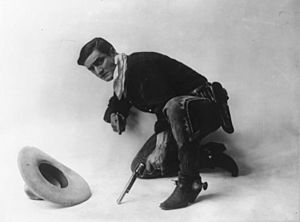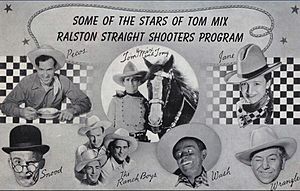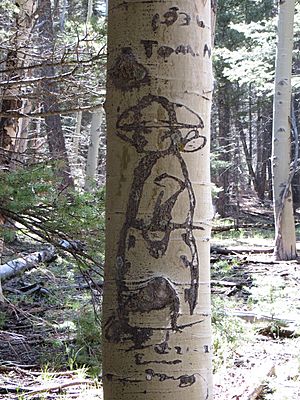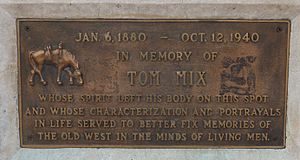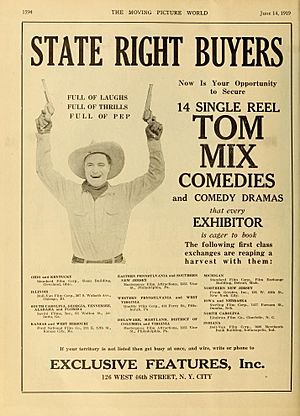Tom Mix facts for kids
Quick facts for kids
Tom Mix
|
|
|---|---|

Mix in 1925
|
|
| Born |
Thomas Hezikiah Mix
January 6, 1880 Mix Run, Pennsylvania, United States
|
| Died | October 12, 1940 (aged 60) Florence, Arizona, United States
|
| Other names | Thomas Edwin Mix |
| Occupation | Actor |
| Years active | 1909–1935 |
| Spouse(s) |
Grace I. Allin
(m. 1902; annulled 1903)Kitty Jewel Perinne
(m. 1905; div. 1906)Olive Stokes
(m. 1909; div. 1917)Victoria Forde
(m. 1918; div. 1932)Mabel Hubbell Ward
(m. 1932) |
Thomas Edwin Mix was a famous American actor. He starred in many early Western movies from 1909 to 1935. He made 291 films, and almost all of them were silent movies. Tom Mix was Hollywood's very first Western star. He helped create the look and feel of cowboy movies in the early days of cinema.
Contents
Early Life and Adventures
Growing Up and Horses
Thomas Hezikiah Mix was born on January 6, 1880, in Mix Run, Pennsylvania. His father was a stable master, meaning he took care of horses. He taught young Tom how to ride and love horses. Tom grew up in DuBois, Pennsylvania, and even worked on a local farm. He dreamed of joining the circus.
Army Days and Early Marriages
In April 1898, Tom Mix joined the Army during the Spanish–American War. His unit did not go overseas. After a short time, he left the Army. He married Grace I. Allin in 1902, but their marriage ended quickly. In 1905, he married Kitty Jewel Perinne, but that marriage also ended within a year. He then married Olive Stokes in 1909. They had a daughter named Ruth in 1912.
Cowboy Skills and Wild West Shows
In 1905, Tom Mix rode in President Theodore Roosevelt's parade. He was part of a group of skilled horsemen. Later, some people mistakenly thought he had been a "Rough Rider" with Roosevelt.
Mix moved to Oklahoma and worked different jobs. He was even a night marshal for a short time. He found work at the Miller Brothers 101 Ranch. This was a huge ranch with its own Wild West show. Tom Mix was a great horseman and a very good shot. He won many riding and roping contests.
Becoming a Movie Star
First Films with Selig Polyscope
Tom Mix started his movie career with the Selig Polyscope Company. His first film was a short called The Cowboy Millionaire in 1909. In 1910, he appeared as himself in a documentary film. It showed his skills with cattle. This film was a big hit, and Tom Mix became an early movie star.
He made over 100 films for Selig. Many were filmed in Las Vegas, New Mexico. While working there, he met and fell in love with Victoria Forde. They starred in several movies together. Tom divorced Olive Stokes in 1917. Selig Polyscope had money problems, so Tom and Victoria moved to Fox Film Corporation. They got married in 1918 and had a daughter, Thomasina, in 1922.
The Golden Age of Cowboy Movies
Tom Mix made more than 160 cowboy films in the 1920s. These movies were full of action. The good guys and bad guys were very clear. The clean-cut cowboy always saved the day! Millions of children watched his films every Saturday. His smart and handsome horse, "Tony the Wonder Horse," also became famous. Tom Mix did all his own stunts. This meant he often got hurt.
In 1913, Mix bought a ranch in Prescott, Arizona. He spent time there when not filming. Some of his movies were even filmed at his ranch. He also won first prize in a bull-riding contest at the Prescott Frontier Days rodeo.
Mixville: A Western Town on Set
Tom Mix earned a lot of money at Fox, about $7,500 a week. He was so famous that he had his initials in electric lights on his house. His movies were known for realistic action and amazing horseback riding. He wore eye-catching cowboy costumes.
At the Fox studio, Mix built a 12-acre movie set called Mixville. It looked like a real frontier town. It had a dusty street, a saloon, a jail, a bank, and houses. There was also an Indian village with fake mountains. It even had a fake desert and a ranch house without a roof for indoor scenes.
Mix sometimes pretended he would leave Hollywood. He would say he would go to Argentina or join the circus. But he always signed new movie deals. He worked for FBO and then Universal. In 1929, he was a pallbearer at the funeral of famous lawman Wyatt Earp.
Later Career and Talkies
In the early 1930s, Tom Mix performed with the Sells-Floto Circus. He earned a lot of money, but he also spent a lot. He and Victoria Forde divorced in 1931.
Universal Pictures offered him a chance to make "talkies" (movies with sound). He made nine films for Universal. But he had many injuries from filming. So, he decided not to make any more movies. He then bought and performed with the Sam B. Dill circus.
His last movie was a 15-episode series called The Miracle Rider in 1935. He was paid $40,000 for four weeks of filming. Many outdoor scenes were filmed at the Iverson Movie Ranch in California. One large rock there is now called Tom Mix Rock. He was filmed climbing down it using carved boot holes.
In 1935, the governor of Texas made Tom Mix an honorary Texas Ranger. Mix went back to the circus, sometimes with his oldest daughter, Ruth. He later went to Europe for promotions.
Radio Show and Legacy
The Tom Mix Ralston Straight Shooters
In 1933, the Ralston Purina company started a radio show called Tom Mix Ralston Straight Shooters. This show was very popular for many years. Tom Mix never actually spoke on the radio show himself. His voice was not good for radio because of past injuries. Other actors played his part. The Ralston company offered special comic books to listeners who sent in cereal box tops.
Death and Memorials

Tom Mix died on October 12, 1940, in Arizona. He was driving his car when he came to a bridge that was washed away by a flood. His car overturned in a gully. A large suitcase in his car hit him, breaking his neck. He was 60 years old.
His funeral was in California. Thousands of fans and Hollywood stars attended. He was buried in the Forest Lawn Memorial Park Cemetery. A small stone memorial marks the spot where he died. The gully nearby is now called "Tom Mix Wash".
Lasting Influence
Tom Mix was known as the "King of Cowboys." He influenced many actors who came after him, like Ronald Reagan and John Wayne. When John Wayne was young, Tom Mix helped him get a job moving props at Fox Studios. This was the start of Wayne's Hollywood career.
Tom Mix made 291 movies. Many of his films were lost in a fire in 1937.
Tom Mix has a star on the Hollywood Walk of Fame. His boot prints and his horse Tony's hoof prints are at Grauman's Chinese Theatre. In 1958, he was added to the Western Performers Hall of Fame. There is also a Tom Mix museum in Dewey, Oklahoma.
Comic Book Appearances
Tom Mix was often shown in comic books. This was especially true in the 1940s and 1950s when Western comics were very popular.
He first appeared in The Comics from 1937 to 1938. The Ralston Purina company, which sponsored his radio show, also made Tom Mix Comics. These comics could be ordered by mail if you sent in cereal box tops.
Fawcett Comics published many issues of Tom Mix Western from 1948 to 1953. Comics featuring Tom Mix were also published in other countries like Sweden, Germany, and Australia.
Images for kids
-
Mix memorial near Florence, Arizona (32°49′17.4″N 111°12′12.5″W / 32.821500°N 111.203472°W), the site of his death
-
Portrait in aspen tree of Tom Mix, dated 1936. Known as "arborglyphs", such carvings were made by young Basque and Irish American shepherds. (Santa Fe National Forest, Río Arriba County, New Mexico)
See also
 In Spanish: Tom Mix para niños
In Spanish: Tom Mix para niños


